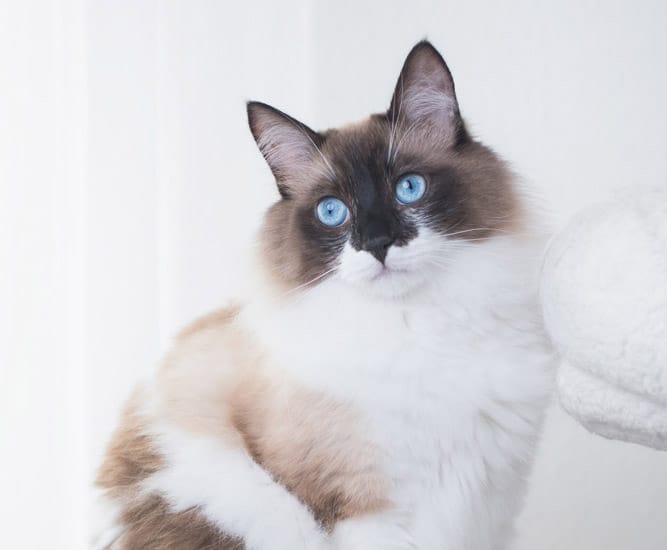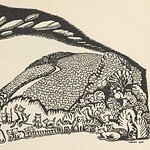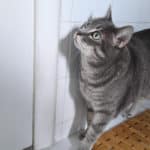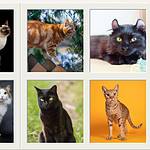Ragdolls are popular cats known for their “puppy” like temperance. Docile and affectionate, the Cat Fanciers’ Association has named the Ragdoll the most popular cat breed three years in a row since 2019.
The breed’s name comes from its tendency to go limp when picked up, much like a ragdoll toy. This trait is indicative of the breed’s generally docile and placid temperament.
Read on to learn more about the ragdoll cat.
1: Ragdolls are a newer breed
The beginning of the Ragdoll breed surprisingly only dates back to the 1960s. A breeder named Ann Baker out of California created the founding cats from the offspring of a semi feral cat. This cat was a white, long-haired beauty named Josephine that belonged to her neighbors, the Pennels [1]
Josephine had been struck by a car while pregnant, but fortunately she survived and was able to give birth to her kittens safely. She was fascinated and enthralled by Josephine and these kittens and began a breeding program to try to maintain the look and temperaments she found so desirable in them.
2: Ann Baker had some pretty outlandish ideas about her Ragdolls
Ann Baker believed quite a few conspiracy theories about rag dolls [2]. Baker believed that Josephine and her kittens were forever changed by the car accident that hurt Josephine. Ann believed that the accident changed their DNA or their chemical makeup.
Later on, she claimed that Ragdolls were the final link between humans and aliens. She also claimed her cats couldn’t feel pain and had no fear. If all that wasn’t enough, Ann firmly believed that the cats had skunk genes.
3: Ragdolls are usually incredibly friendly and laid back.
Ragdolls continue to grow in popularity because they are one of the friendliest and most outgoing breeds of cats. Many people describe their temperament as being like that of a dog. Maybe Ann was so surprised by this friendly breed that the only explanation she could think of was that they were related to aliens!
Ragdolls are known to love playing fetch and running to greet their humans at the door when they come home. They are definitely “people-cats.”
Ragdolls are also known for being laid back — so laid back, these cats have a tendency to go limp when picked up. In fact, this personality trait is similarly to how a ragdoll flops, hence the breed’s name.
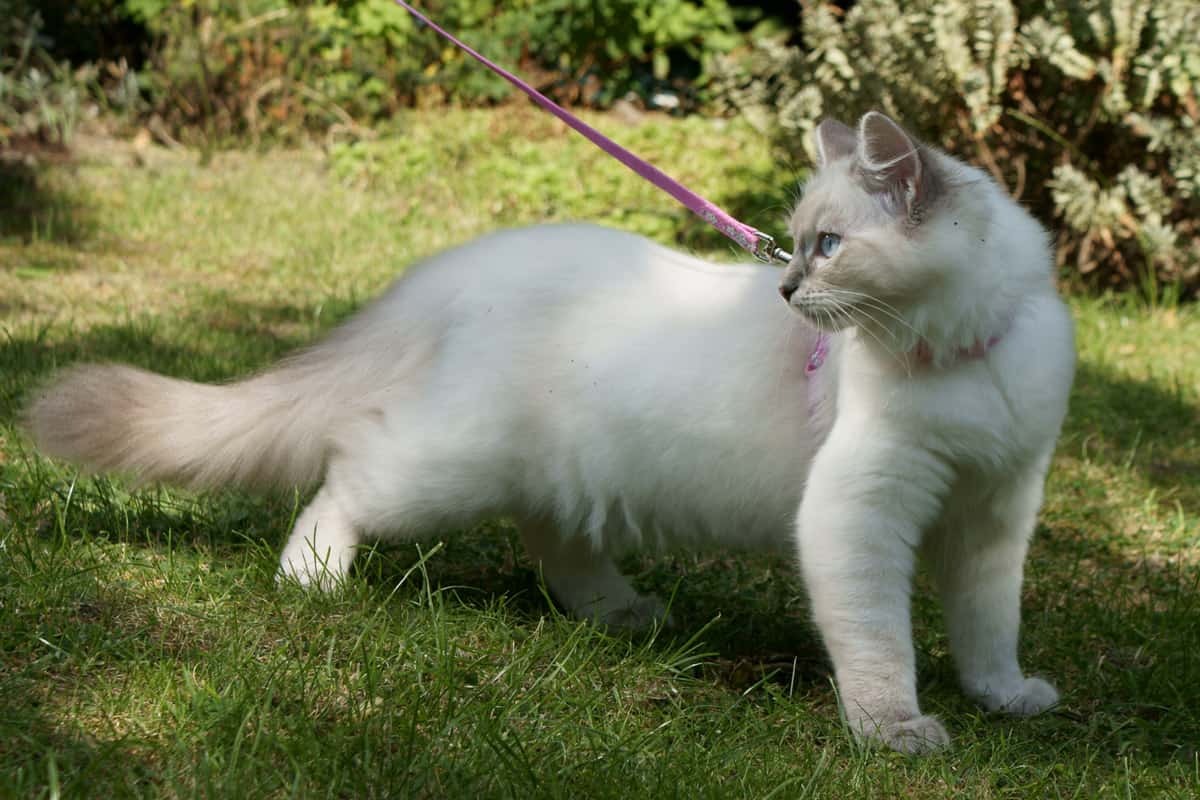
4: Ragdolls can come in an array of colors and patterns.
The four patterns Ragdolls come in are as follows:
- Bi-color
- Van
- Mitted
- Colorpoint
All the patterns can exist in six colors which are:
- Seal
- Blue
- Chocolate
- Lilac
- Red
- Cream
A ragdoll’s color points can be solid, lynx, tortie, or torbie. The Cat Fanciers’ Association officially recognizes all of these various patterns and colors as a part of the breed standard for Ragdolls [3].
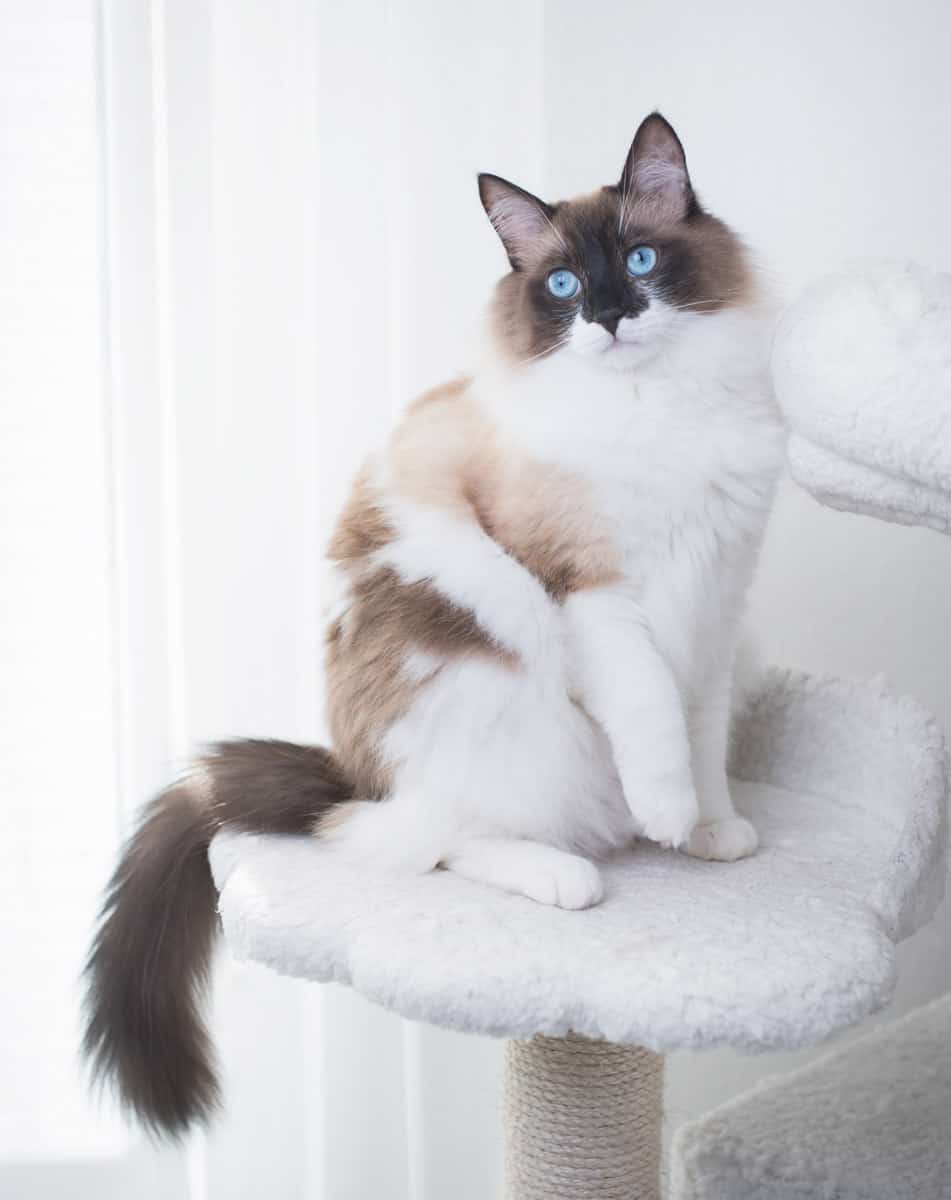
5: Ragdoll cats always have blue eyes.
A Ragdoll’s eyes can be different shapes and have different sizes as well as different shades of blue, but purebred Ragdolls always have blue eyes. Their big, sparkling blue eyes are often a favorite characteristic for fans of the breed!
6: Ragdolls are large cats
Ragdolls are one of the larger breeds of cats. And they aren’t just all fluff like you might think! Even underneath their long beautiful coat, females weigh anywhere from 10 to 15 pounds, and males can weigh up to 20 pounds or more.
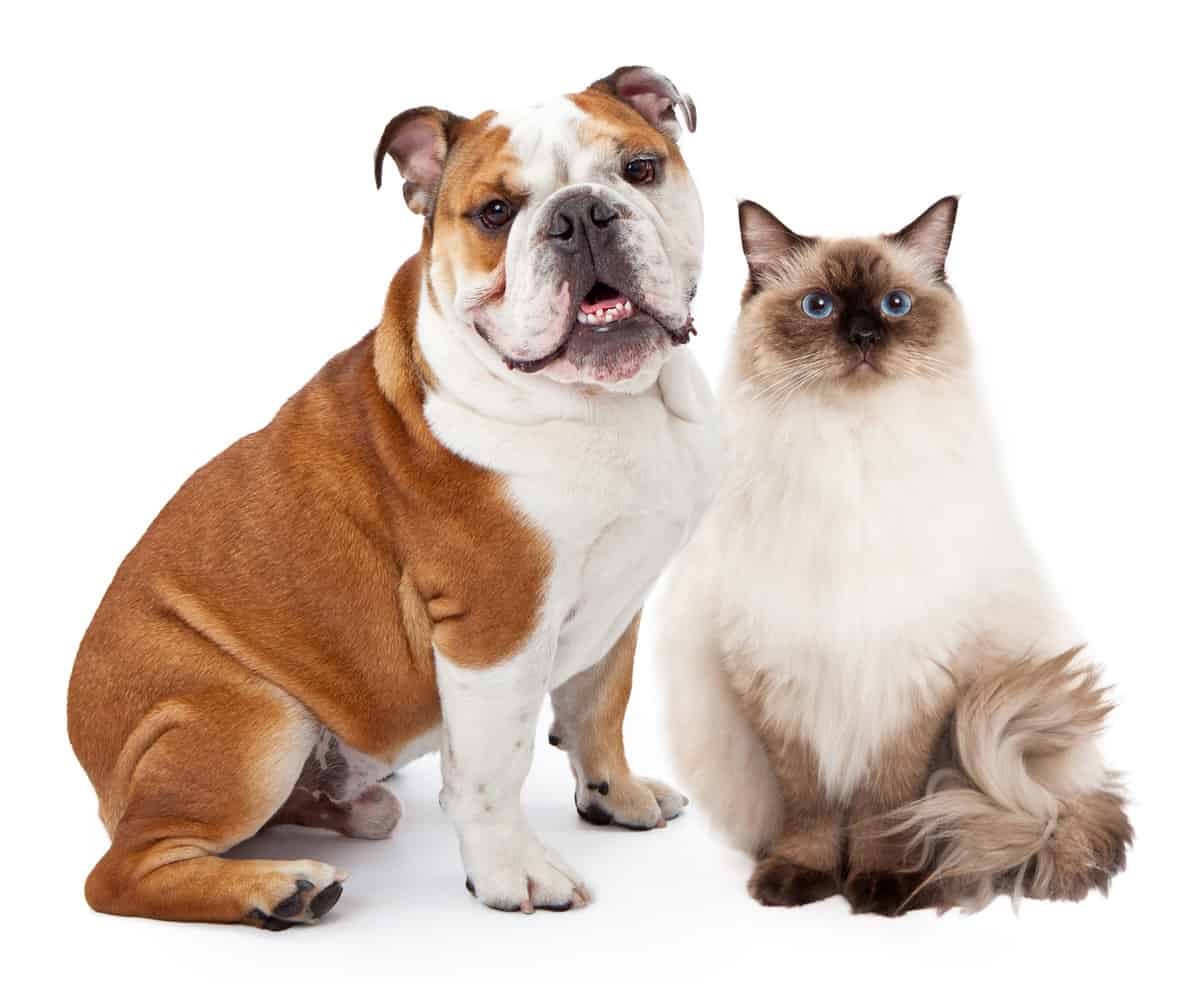
7: Ragdolls were so named because they act just like a rag doll
This breed of cat was named ragdoll because the original kittens and cats liked to go limp and completely relaxed when they were picked up. Just like a ragdoll! They wouldn’t tense up at all and were perfectly content to let humans hold them. This characteristic still holds true today for most Ragdoll cats.
8: Ragdolls are quiet kitties
They don’t vocalize as loudly or as often as other domestic cats do. Some think this may be the reason why Baker thought her cats couldn’t feel pain.
Cats, by nature, tend to hide their pain and their ill health. But ragdolls are even quieter than regular cats, so they are even less likely to let their owners know if they are in pain.
Instead, ragdoll cats often use body language to communicate rather than vocalizations.
9: A ragdoll went down in history as the longest living Janus cat
A Janus cat is a rare oddity that occurs when a cat is born with two faces, like the god Janus. Frankenlouie, or Frank and Louie, was a Ragdoll who lived to be fifteen years old before he passed away in 2014. Frankenlouie’s advanced age gave him a special place in the Guinness Book of World Records as the longest-living Janus cat. [4]
He had two eyes that worked, an eye in the middle of his face(s) that was blind, two noses, and two mouths. Frankenlouie had a rare congenital condition called diprosopia. Diprosopia, also known as craniofacial duplication, is an extremely rare congenital disorder characterized by the duplication of facial features.
10: Ragdolls have long hair but their coat is easy to maintain
Unlike many other cat breeds, the Ragdoll cats’s semi-longhair coat lacks an undercoat, which is typically a protective layer. This makes their fur mat and shed less, but it also means they are more sensitive to cold temperatures.
Ragdoll cats just need a good brush-out a couple of times a week instead of every day like some other long-haired breeds. A stainless-steel comb is usually most often recommended for ragdoll cats.
11: Ragdolls take a long time to fully mature
Often referred to as “late bloomers,” Ragdolls take a long time to reach official adulthood. It takes three to four years before they reach their full size and their coat is fully established in its final colors.
12: They are one of the most popular breeds of cat
Ragdolls are quite popular because of their amiable, friendly disposition and because of their good looks. Because of this, they can also be very expensive.
Some breeders ask as much as 2,500 dollars for one kitten. For a kitten from a reputable breeder who does the minimum health testing for the betterment of the breed, most can be expected to pay at least $1,000 or more.
13: Ragdoll cats are born completely white
Their colors don’t start to show until they are about one to two weeks old! Ragdolls are one of several breeds of cats known as colorpoint breeds.
A colorpoint cat is unique because the gene responsible for its color has a mutation that makes it sensitive to temperature. So, the warmer areas of their body, like their torso, will have a lighter color than the cooler locations of their body, like their ears, tail, parts of their face, and feet, which have more pigmentation. These areas are called points.
14: Ragdolls have an above average lifespan
As mentioned with Frankenlouie, the longest living Janus cat who lived to the ripe age of 15 years old, Ragdolls as a breed have an above-average lifespan expectancy. An indoor Ragdoll can be expected to live anywhere from 15 to 20 years of age. Related: How Long Do Domestic Cats Live?
15: Ragdolls love water
Ok, maybe love is a strong word to use for all Ragdoll cats when it comes to water. But they do seem to at least like water more than the average cat. Owners often report that their ragdoll cat likes to run into the kitchen anytime they hear the faucet turn on or want to be close by when their human is in the shower!
Are ragdoll and snowshoes the same cat breed?
Despite some similarity in their appearances, the ragdoll and snowshoe cat are two separate breeds of cats. While both are blue-eyed cats with colorpoint markings, a white “V’ muzzle and fitted feet, the ragdoll is a semi-longhaired large cat that averages 15 to 20 pounds. The snowshoe cat is a medium to large shorthaired cat that averages between 7 to 14 pounds.
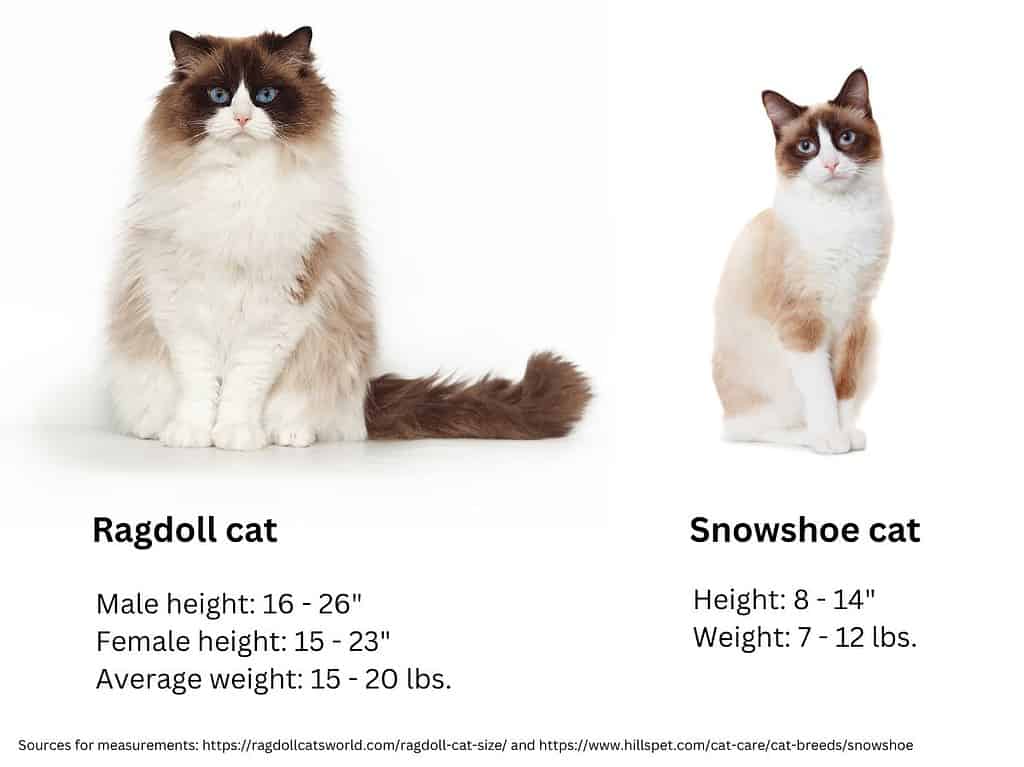
References
[1] Ragdoll History. (n.d.). Ragdoll Fanciers Club International . rfci.org/ragdoll-history/
[2] Nunn, L. (n.d.). Ragdoll cat – History and myths. Cat Breeds World. https://www.catbreedsjunction.com/ragdoll-cat.html
[3] Ragdoll. (n.d.). The Cat Fanciers’ Association. https://cfa.org/ragdoll/
[4] Two-faced cats: How do they get that way? (2014, December 6). National Geographic. https://www.nationalgeographic.com/animals/article/141205-janus-cat-two-faced-frank-louie-animals-science
This article was first published on July 12, 2022 and has since been updated.

